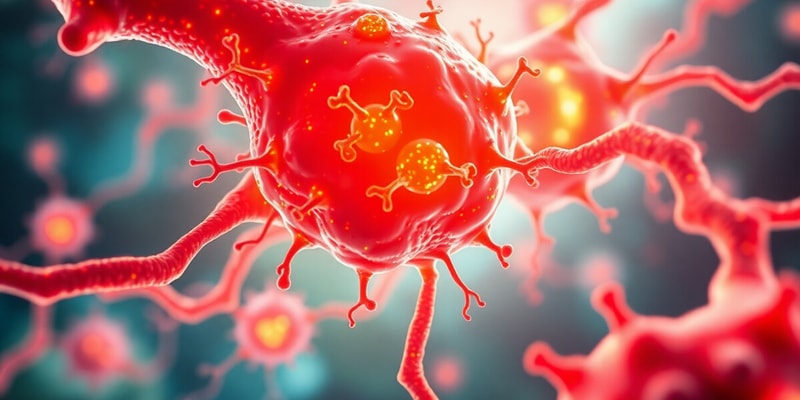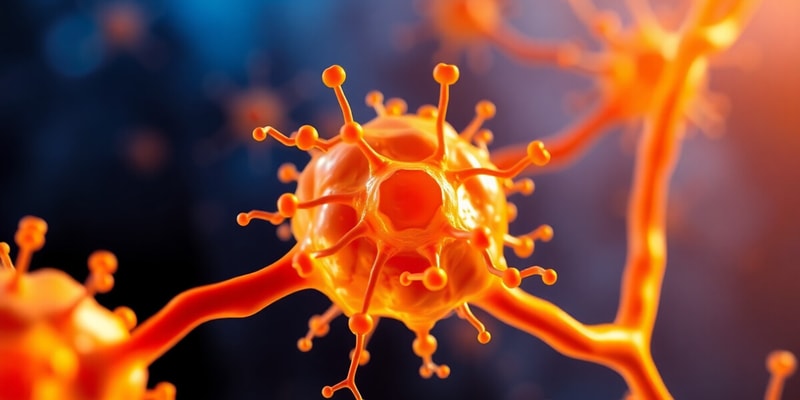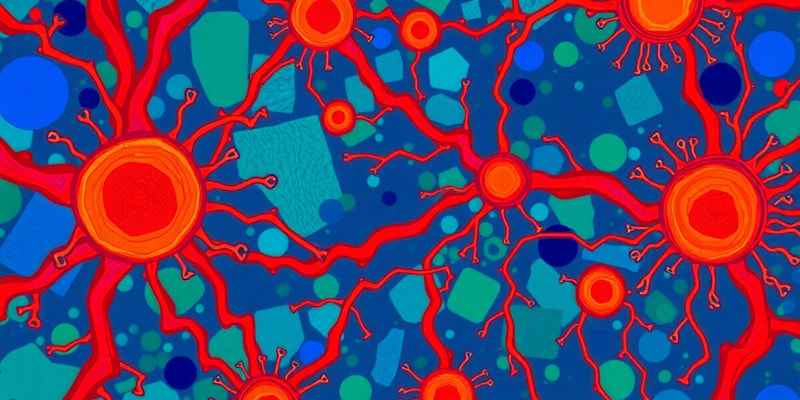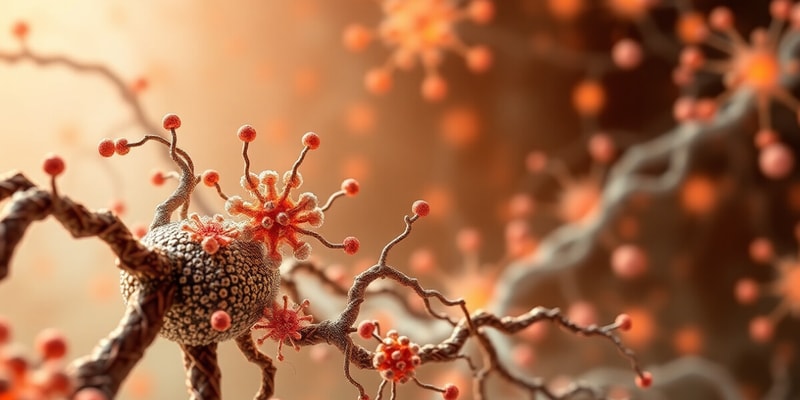Podcast Beta
Questions and Answers
What is one of the primary functions of cell surface receptors?
What process may require ligand-induced clustering of receptor proteins?
Which enzymes are responsible for adding phosphate groups during signal transduction?
What occurs during the initial cytosolic phase of signal transduction?
Signup and view all the answers
What role do non-receptor tyrosine kinases play in cellular receptor activation?
Signup and view all the answers
Where are nuclear receptors typically activated?
Signup and view all the answers
Which amino acids are commonly involved in phosphorylation by protein kinases?
Signup and view all the answers
What is a defining characteristic of receptor tyrosine kinases (RTKs)?
Signup and view all the answers
What typically triggers intracellular signaling leading to cell activation?
Signup and view all the answers
Which receptors are typically classified as nuclear receptors?
Signup and view all the answers
What mechanism do G protein-coupled receptors (GPCRs) use after ligand binding?
Signup and view all the answers
Which of the following is NOT a function of cell surface receptors?
Signup and view all the answers
What is the primary function of receptors in the Notch family?
Signup and view all the answers
Which of the following processes is influenced by nuclear hormone receptors?
Signup and view all the answers
What type of receptors require ligand-induced proteolytic cleavage for activation?
Signup and view all the answers
Which receptors are involved in the immune response and inflammation?
Signup and view all the answers
What is the primary function of the synapse in T cell activation?
Signup and view all the answers
Which transcription factors are critical for T cell responses following antigen recognition?
Signup and view all the answers
What role does phosphorylation of ITAMs play in T cell signaling?
Signup and view all the answers
What contributes to the termination of T cell activation?
Signup and view all the answers
What is the initial event that occurs within seconds of TCR ligation?
Signup and view all the answers
What is a characteristic of non-receptor tyrosine kinases?
Signup and view all the answers
How do receptor tyrosine kinases (RTKs) become activated?
Signup and view all the answers
What type of receptor typically has ITAMs in its structure?
Signup and view all the answers
What function do nuclear receptors typically have?
Signup and view all the answers
What describes a T cell receptor (TCR)?
Signup and view all the answers
Which receptors have ITIM motifs on their cytosolic portion?
Signup and view all the answers
Which components contribute to the antigen-binding portion of the TCR?
Signup and view all the answers
What differentiates inhibitory receptors from activating receptors in the immune system?
Signup and view all the answers
What are the hypervariable regions in TCRs primarily responsible for?
Signup and view all the answers
Which of the following describes the role of CD4 and CD8 in T cell activation?
Signup and view all the answers
How do CD4 and CD8 differ in their interactions with MHC classes?
Signup and view all the answers
What is a key structural feature of the CD4 molecule?
Signup and view all the answers
What is the relationship between TCRs and the immune synapse?
Signup and view all the answers
Which statement accurately describes the composition of the CD8 molecule?
Signup and view all the answers
What characterizes the CDRs in TCRs?
Signup and view all the answers
What is the primary function of costimulatory receptors in T cell activation?
Signup and view all the answers
Study Notes
Cell Surface Receptors
- Cell surface receptors can be triggered by external ligands.
- Primary functions of these receptors are the induction of intracellular signaling, cell to cell adhesion or adhesion to the extracellular matrix, and internalization of extracellular molecules and cells.
- The initial phase involves the cytoplasmic portion of the receptor or interacting proteins and their enzymatic modification.
- Transcription factors that are silent in resting cells can lead to an activation or nuclear translocation, followed by a nuclear phase where the transcription factors orchestrate changes in gene expression.
Signal Transduction
- Also known as intracellular signaling pathways, these pathways can be initiated by ligands and receptors on the plasma membrane.
- Nuclear receptors activate by lipid soluble ligands that can cross the plasma membrane, and are found intracellularly.
- Signaling can involve ligand-induced clustering of receptor proteins known as cross-linking, or may involve conformational changes of the receptor after association with ligand.
Addition/Removal of Phosphate
- Signal transduction commonly involves the addition of a phosphate residue on a tyrosine, serine, or threonine side chain.
- Enzymes called protein kinases add phosphate groups onto amino acid side chains.
- Protein tyrosine kinase phosphorylates specific tyrosine residues.
Categories of Cellular Receptors
- Non-receptor tyrosine kinases have no intrinsic catalytic activity but a separate intracellular tyrosine kinase known as a non-receptor tyrosine kinase, participates in receptor activation by phosphorylating specific motifs.
- Receptor tyrosine kinases (RTKs) are an integral membrane protein, and activate an intrinsic tyrosine kinase domain in the cytoplasmic tails of the receptor when cross-linked by multivalent extracellular ligands.
- Nuclear receptors are located in, or migrate to the nucleus to function as transcription factors.
- G-protein coupled receptors (GPCRs), can activate GTP-binding proteins (G-proteins) that are associated with the receptor.
- Receptor proteins of the Notch family are involved in development and the association of specific receptors leading to proteolytic cleavage of the receptor and the nuclear translocation of the cleaved cytoplasmic domain, a component of a transcription complex.
Immune Receptor Family
- Immune receptors have separate polypeptide chains for recognition and associated polypeptide chains that contain cytosolic immunoreceptor tyrosine-based activation motifs (ITAMs).
- B cell receptor (BCR), T cell receptor (TCR), and the high-affinity receptor for IgE (FcεRI) have ITAMs motifs.
- Inhibitory receptors typically have ITIM motifs on the cytosolic portions of the same chain that uses its extracellular domain for ligand recognition.
- FcγRIIB is an inhibitory receptor found on B cells and myeloid cells.
- PD-1, an inhibitory receptor found on T cells, also has an immunotyrosine based “switch” motif in its cytoplasmic tail.
T Cell Receptor for Antigen
- The antigen receptor of MHC-restricted CD4+ and CD8+ T cells is a heterodimer consisting of transmembrane polypeptide chains, designated TCR α and β. They are covalently linked by a disulfide bridge between extracellular cysteine residues.
- The antigen-binding portion of the TCR is formed by the Vβ and Vα domains.
- The hypervariable segment loops that form the peptide-MHC binding site are at the top.
Binding of TCR to an MHC Molecule
- The V regions of the TCR α and β chains contain short stretches of amino acids where the variability between different TCRs is concentrated and form the hyper-variable or complementarity-determining regions (CDRs).
- Three CDRs in the α chain and three in the β chain form the part of the TCR that specifically recognizes peptide-MHC complexes.
Components of the TCR Complex
- CD4 and CD8 are T cell coreceptors that bind to nonpolymorphic regions of MHC molecules, and facilitate signaling by the TCR complex during T cell activation.
- Mature αβ T cells express either CD4 or CD8 but not both.
- CD8 and CD4 interact with class I and class II MHC molecules, respectively.
Role of the CD4 and CD8 Coreceptors in T Cell Activation
- CD4 has four extracellular Ig-like domains, a hydrophobic transmembrane region, and a highly basic cytoplasmic tail.
- The two N-terminal Ig-like domains of the CD4 protein bind to the nonpolymorphic α2 and β2 domains of the class II MHC molecule.
- Most CD8 molecules exist as disulfide-linked heterodimers composed of chains called CD8α and CD8β.
- The CD8 α and β chains have a single extracellular Ig domain, a hydrophobic transmembrane region, and a highly basic cytoplasmic tail.
The Immune Synapse
- Forms a stable contact between an antigen-specific T cell and an APC displaying that antigen, and serves as the site for assembly of the signaling machinery of the T cell.
- The immune synapse provides a unique interface for TCR triggering, thus facilitating prolonged and effective T cell signaling.
- Allows the specific delivery of secretory granule contents and cytokines from a T cell.
- May also be an important site for the turnover of signaling molecules.
Signal Transduction
- Phosphorylation of proteins and lipids plays a significant role in TCR complex and coreceptor signal transduction.
- There is some basal tyrosine phosphorylation of ITAM tyrosines and some recruitment of ZAP-70, to these phosphorylated ITAMs.
- Lck phosphorylates the ITAMs of the CD3 and ζ chains.
Calcium- and Protein Kinase C-Mediated Signaling Pathways in T Lymphocytes
- Multiple signaling pathways are activated during T cell activation, including calcium- and protein kinase C-mediated signaling pathways.
- Binding of a ligand can lead to phosphorylation of the receptor.
Activation of Transcription Factors That Regulate T Cell Gene Expression
- Different transcription factors are activated by different cytoplasmic signal transduction pathways.
- Multiple transcription factors are needed to activate many signaling pathways.
- Three transcription factors that are activated in T cells by antigen recognition include nuclear factor of activated T cells (NFAT), AP-1, and NF-κB.
Studying That Suits You
Use AI to generate personalized quizzes and flashcards to suit your learning preferences.
Related Documents
Description
This quiz explores the essential roles of cell surface receptors and the processes involved in signal transduction. Learn about the interaction of ligands with receptors and the subsequent intracellular signaling mechanisms that lead to changes in gene expression. Test your knowledge on how these receptors function in cellular communication and response.




